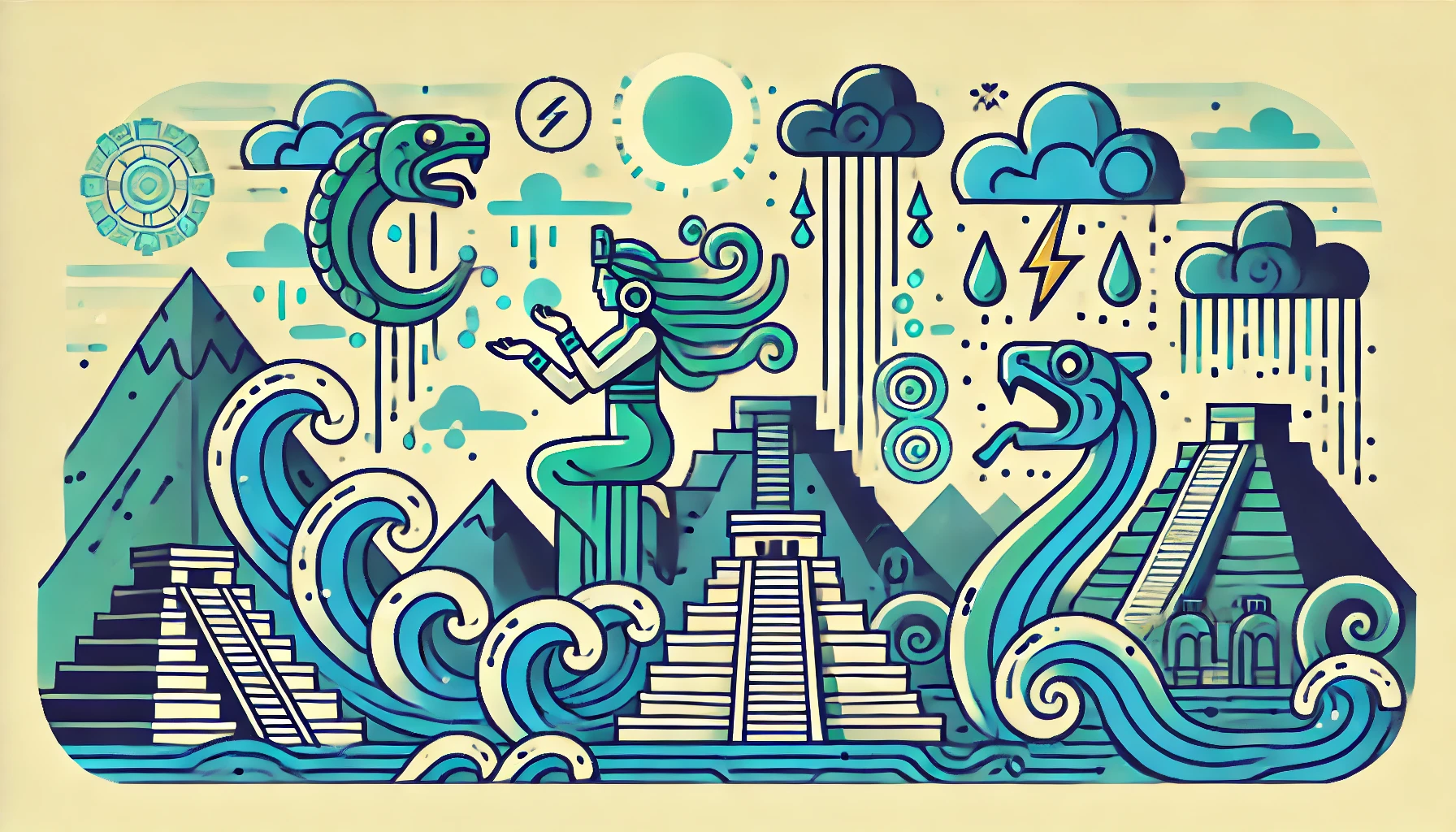Interpretation Of The Aquatic Elements Associated With Monument 21 Of Chalchuapa And Their Relationship With The Deities Chalchiuhtlicue And Tlaloc
DOI:
https://doi.org/10.5281/zenodo.12608235Keywords:
Post-processual Archaeology, Symbolic Archaeology, Ethnosphere, Mesoamerica, Water, SDG 4 , SDG 10, SDG, ArchaeologyAbstract
EN | Abstract
The following paper tackles the significant interpretation of the aquatic elements in the context of monument 21 of Chalchuapa, a Mesoamerican archaeological site of great historical and cultural relevance. The central focus is targeted towards the veneration of the deities Chalchiuhtlicue, goddess of running water, and Tlaloc, god of rain. Through an exhaustive documental exploration and a profound review of the decorations and artifacts related, this study looks to shed some light over the crucial role that these aquatic deities had in the worldview and the religious practices of the Mesoamerican civilization. Furthermore, the influence and management of water resources shall be analyzed as well as the comprehension between humanity and nature in an archaeological environment as unique as Chalchuapa.
References
Amaroli, P. (2015). Arqueología de El Salvador. Fundación Nacional de Arqueología de El Salvador (FUNDAR).
Anderson, B. A. (1978). Excavations at Laguna Cuzcachapa and Laguna Seca. En R. J. Sharer (Ed.), The Prehistory of Chalchuapa, El Salvador (Vol. 1). University of Pennsylvania Press.
Anderson, D. (1978). Monuments. En R. J. Sharer (Ed.), The Prehistory of Chalchuapa, El Salvador (Vol. 1). University of Pennsylvania Press.
Bahn, P., & Renfrew, C. (2008). Arqueología. Conceptos Clave. Ediciones AKAL.
Barberena, S. I. (1910). Monografías Departamentales. VI. Departamento de Santa Ana. Imprenta Nacional.
Boggs, S. H. (1944). Excavations in Central and Western El Salvador. En J. M. Longyear III, Memoirs of the Peabody Museum of Archaeology and Ethnology Archaeological Investigations in El Salvador (Vol. IX No. 2). Peabody Museum of Archaeology and Ethnology.
Centro Nacional de Registros & Instituto Geográfico Nacional «Ing. Pablo Arnoldo Guzmán». (1985). Diccionario Geográfico de El Salvador (Vol. 1 A-K). Talleres Litográficos del Instituto Geográfico Nacional “Ingeniero Pablo Arnoldo Guzmán”.
Cobos, R. (1995). Síntesis de la Arqueología de El Salvador (1850-1991). Dirección de Publicaciones e Impresos.
Couvreur, A. (2011). Entre sceptres divins et instruments de musiques cérémoniels. Le symbolisme des bâtons de sonnailles aztèques. En N. Ragot, S. Peperstraete, & G. Olivier (Eds.), La quête du serpent à plumes. Arts et religions de l’Amérique précolombienne. Hommage à Michel Graulich (pp. 235-250). Brepols Publishers.
Demarest, A. A. (1988). Political Evolution in the Maya Borderlands: The Salvadoran Frontier. En E. Hill Boone & G. Willey (Eds.), The Southeast Classical Maya Zone. Dumbarton Oaks Research Library and Collection.
De Sahagún, B. (2006). Historia general de las cosas de Nueva España. Editorial Porrúa.
Extrema Percusión ESPJ. (2023, 17 enero). ¿Qué son los instrumentos idiófonos? Diferentes tipos y ejemplos. Extrema Percusión. Recuperado de https://extremapercusion.com/instrumentos-percusion-idiofonos/
FAMSI - John Pohl - Libros antiguos - El Grupo Borgia - Códice Ríos. (s. f.). Recuperado de http://www.famsi.org/spanish/research/pohl/jpcodices/rios/index.html
Fowler, W. R. (1995). El Salvador: Antiguas Civilizaciones. Banco Agrícola Comercial de El Salvador. Haff-Daugherty Graphics.
Gómez, L. A. (2008). Los Instrumentos Musicales Prehispánicos: Clasificación General y Significado. Arqueología Mexicana, 16(94).
González Torres, Y. (1995). Diccionario de Mitología y Religión de Mesoamérica. Larousse Kingfisher Chambers.
Hernández, W. (2016). Nawat Mujmusta. Recuperado de http://tushik.org/wp-content/uploads/HER-mujmusta.pdf
Huehue - Gran diccionario Náhuatl. (s. f.). Recuperado de https://gdn.iib.unam.mx/diccionario/huehue/17154
Ichikawa, A., Shibata, S., & Murano, M. (2009). El Preclásico Tardío en Chalchuapa: Resultados de las investigaciones de la Estructura 5 en el Parque Arqueológico Casa Blanca. XXII Simposio de Investigaciones Arqueológicas en Guatemala, 2008. Recuperado de https://www.asociaciontikal.com/simposio-22-ano-2008/040-ichikawa-et-al-08-doc/
Lardé y Larín, J. (1959). La Estela de Tazumal. Talleres del Departamento Editorial del Ministerio de Cultura.
López Austin, A. (1999). Tamoanchan y Tlalocan. Fondo de Cultura Económica.
López Austin, A., & López Luján, L. (2004). El Templo Mayor de Tenochtitlan, el Tonacatépetl y el Mito del Robo del Maíz. En M. T. Ugarte & L. Staines Cicero (Eds.), Acercarse y Mirar: Homenaje a Beatriz de la Fuente. Universidad Nacional Autónoma de México Instituto de Investigaciones Estéticas.
López Luján, L. (1997). Llover a Cántaros: El Culto a los Dioses de la Lluvia y el Principio de Disyunción en la Tradición Religiosa Mesoamericana. En Pensar América: Cosmovisión Mesoamericana y Andina. Obra social y cultural Cajasur Ayuntamiento de Montilla.
Manzanilla, L. (1993). El Mundo Clásico Mesoamericano. En L. Manzanilla & L. López Luján (Eds.), Atlas Histórico de Mesoamérica (2a ed.). Larousse.
Plunket, P., & Uruñuela, G. (2012). Montañas vivas y montañas sagradas, entes icónicos de la autoridad ancestral en Mesoamérica. Journal of Cultural Symbiosis Research, 7, 39-51. Recuperado de https://www.academia.edu/44012013/4_Montañas_vivas_y_montañas_sagradas_entes_icónicos_de_la_autoridad_ancestral_en_Mesoamérica
Pugliese, F. (2021). Nuevas reflexiones sobre el proceso de fusión de los dioses mexicas: Chalchiuhtlicue, un estudio de caso. Estudios De Cultura Náhuatl, 62, 143-186. Recuperado de https://nahuatl.historicas.unam.mx/index.php/ecn/article/view/77998
Schultes, R. E., Hofmann, A., & Rätsch, C. (2010). Plantas de los Dioses: Orígenes Alucinógenos. Fondo de Cultura Económica.
Solís, F. (1981). Esculturas del Castillo de Teayo, Veracruz, México. Universidad Nacional Autónoma de México.
Spranz, B. (2006). Los Dioses en los Códices Mexicanos del Grupo Borgia: Una Investigación Iconográfica con 32 Ilustraciones y 1791 Figuras en el Texto. Fondo de Cultura Económica.

Published
How to Cite
Issue
Section
Categories
URN
License
Copyright (c) 2024 Diego Gonzalez Argumedo

This work is licensed under a Creative Commons Attribution-NonCommercial 4.0 International License.
All authors who publish their work in this journal give their patrimonial rights in favor of the JMSHRS on a non-exclusive basis. This means that authors may enter into other independent and contractual agreements to disseminate their text published in this journal. Such as, for example, including it in an institutional, thematic or other repository, publishing it in a book, or other digital or physical media, as long as they explicitly indicate that the work was first published in this journal.
The responsibility for the content of each published work corresponds exclusively to the authors themselves, excluding the editors from any legal responsibility.
The contents of the journal will be disseminated under a Creative Commons Attribution-NonCommercial 4.0 International (CC BY-NC 4.0). All issues are open access (OA) from the moment of publication.




